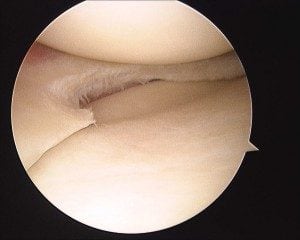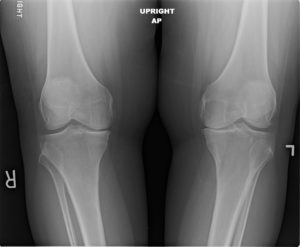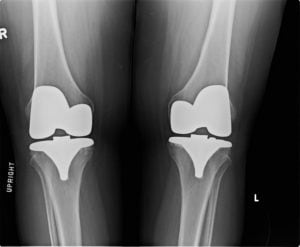Knee Pain in Younger Patients
In younger patients, knee pathology often involves sports related injuries such as meniscal and ligament tears. Surgery to treat the injured meniscus or ligament is almost always minimally invasive utilizing arthroscopic techniques.
Another condition commonly affecting young athletes is patellofemoral disorders (disorders involving the patella or “kneecap”). Physical therapy can be helpful in the treatment of these conditions. For those requiring surgery, there are several excellent techniques for treating disabling patellofemoral pain.

Medial meniscal tear in 49 yo male cyclist. Patient had 3 months of pain and mechanical symptoms prior to seeking treatment.

Patient underwent arthroscopic partial medial meniscectomy. This tear was not repairable. Patient had complete resolution of pain and mechanical symptoms 1 week after surgery and has returned to cycling.
Knee Replacement Information
Please click on one of the options below to learn more about specific disorders of the knee and treatment options that are available.
Causes of Knee Pain in Older Patients
As patients move into adulthood problems can arise with the articular cartilage that cushions the knee. Isolated loss of cartilage can be treated with minimally invasive arthroscopic procedures designed to restore cartilage to the areas of deficiency. These include techniques such as microfracture and chondrocyte implantation. When there is significant global loss of cartilage within the knee then osteoarthritis can result. This condition can be highly painful and disabling for patients.
Knowing How to Treat Knee Pain
Medications and injections can help with symptoms. But, for some patients, surgery becomes necessary. Knee replacement, either partial or total, is a remarkably successful procedure when performed by an experienced surgeon. New technology is allowing for the customization of total hip and knee replacement surgeries and also increasing the expectant lifespan of these prostheses.

61 yo female with disabling bilateral knee pain. Radiographs demonstrate loss of medial joint space and osteoarthritis. Patient was unable to control symptoms with cortisone injections, Synvisc injections, and anti-inflammatory medication.

Patient elected to undergo bilateral total knee replacement for severe osteoarthritis. At 2 month follow up patient was ambulating independently with a marked reduction in pain and improvement in quality of life.
A Well-Trained and Experienced Knee Replacement Specialist
Dr. Wind has fellowship training and significant experience in both arthroscopic surgery of the knee as well as primary and revision knee replacement. He is one of the few orthopedic surgeons in Virginia to complete fellowship training in both of these specialties. Please click on any of the side tabs to learn more about specific disorders of the knee and treatment options that are available.
